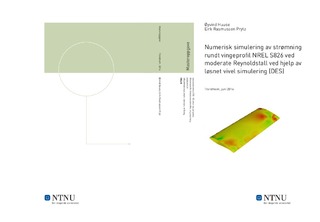| dc.description.abstract | In this study computational fluid dynamics (CFD) was used to simulate the flow around the asymmetric NREL S826 airfoil. ANSYS Fluent v.16.2 was used as the CFD solver, while ANSYS Meshing was used for creating the grids.
The 3D domain was built as a replica of the low speed wind tunnel at the Norwegian University of Science and Technology (NTNU), with the walls of the windtunnel approximated as slip walls. This is done so that grid refinements not are needed towards the walls. The flow was simulated at medium to low Reynolds numbers in the range $5\cdot10^4 - 10^6$. The goal was to see if any improvement could be made by using detached eddy simulation (DES), a hybrid Reynolds-averaged Navier Stokes (RANS) - large eddy simulation (LES) turbulence model, compared to the 2D RANS simulations. Thereby, the quality of DES simulation results was to be assessed to check whether DES constitutes a viable alternative to the computationally more costly LES.
Reviewing the DES literature, it was found that the Delayed DES (DDES) is now the new standard hybrid scheme and was therefore used in almost all simulations.
A time step study was performed to determine a criterion for the time step size leading to efficient and accurate simulations. Then a grid dependence study was run, while refining the grid in one direction at a time to better be able to determine what refinements actually affect the solution. The grid is very important, as in DDES the grid size is also involved in deciding where to use the different models. It was shown that the solution was not grid independent and that refinements in the spanwise direction gave more 3D effects. To be able to run the whole analysis a grid leading to good accuracy and not too high computational costs was chosen.
After testing numerous numerical settings, a choice was made to continue with the realizable $k-\epsilon$ model as RANS model in DDES. This choice was made based on both computational time and accuracy of the simulation results compared with measurements in the NTNU low wind speed windtunnel. A Reynolds number study was conducted where the DDES was compared with experimental values and the LES study from the Technical University of Denmark (DTU).
DDES was found to perform better than 2D RANS results and even as well as an LES study at a fraction of the computational costs. While being able to remove many cells due to the lower resolution criteria in DDES compared to LES, one can use that saved computational power to build a much more accurate geometry that might even produce more accurate results than the LES. Stall cells over the suction side of the airfoil were also observed in the stall region. The observed Reynolds dependency around the stall angles should be examined more thoroughly in future studies. | |

